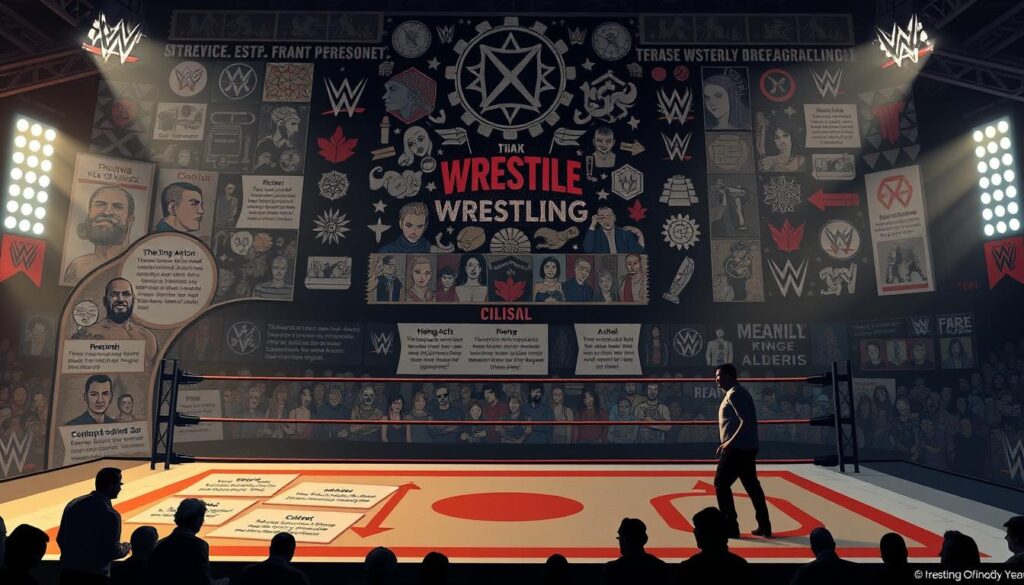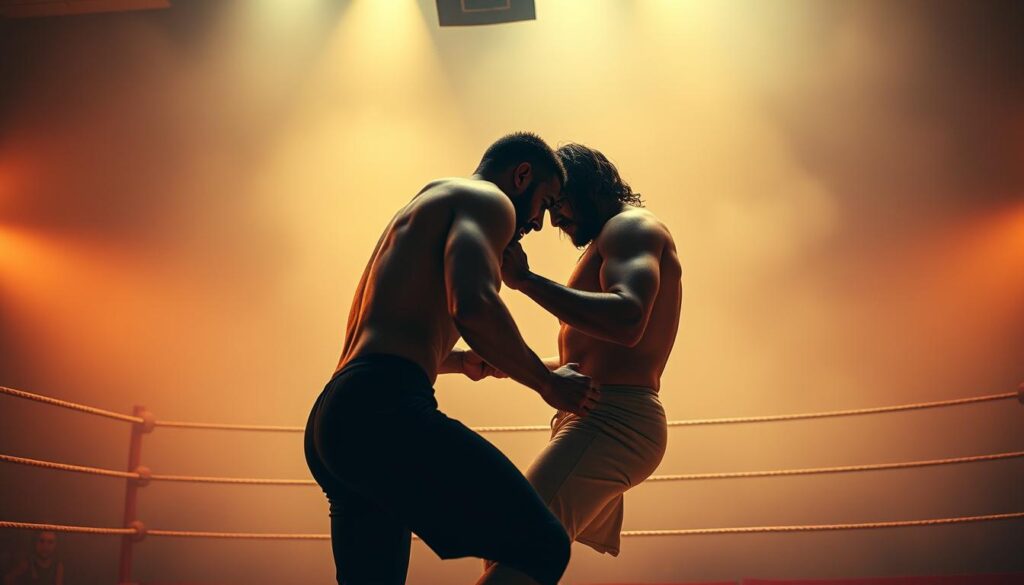Imagine sweat flying through stadium lights as 15,000 voices cheer for nothing. Just as fans compare odds at Florida sportsbooks, in 2019, Japanese fans went wild for an “invisible match.” Two wrestlers acted out slams and suplexes to thin air. We cheered for ghosts. Clapped for shadows.
This makes us question: what truth are we really chasing when the show goes on without bodies?
The ring is like a Zen garden, where stories grow through piledrivers instead of pebbles. It’s like Alan Watts’ “celebration of the present moment.” Every clothesline and pinfall is like ink in wrestling’s living manuscript. You don’t just watch this performance—you breathe it with the crowd.
This communal exhale turns scripted violence into something sacred.
Modern grappling shows our TikTok-era paradox. We know it’s staged, yet we feel the gut-punch of betrayal when heroes turn villain. The mat isn’t just canvas – it’s a Rorschach test.
Do we see sport? Theater? Or something deeper, where athleticism and mythology perform a chokehold on reality itself?
This isn’t just about spandex and suplexes. It’s kinetic philosophy wearing elbow pads, asking uncomfortable questions through body slams. If wrestling can make us believe in invisible combatants, what else might we be willing to accept – both in the arena, and beyond its lights?
Defining “Art” in Wrestling
Imagine if wrestling’s fame was tied to the same question that made Banksy’s shredded painting worth $25 million. That artwork’s value soared after it self-destructed. This mirrors wrestling’s paradox: our willing participation in its layers turns set outcomes into real, felt experiences.
Let’s explore this through sociologist Claire Edwards’ framework of wrestling’s three reality layers:
- Kayfabe: The scripted fiction everyone pretends is real
- In-ring reality: Actual athletic risks and unscripted moments
- Meta-reality: Fans’ ironic enjoyment of the artifice itself
This framework shows why WWE’s Vegas shows and AEW’s focus on athleticism both count as art. They just use different styles. WWE emphasizes narrative theater with pyrotechnics and Undertaker’s rises from coffins. AEW, on the other hand, focuses on athletic storytelling with long, complex matches.
| WWE (Theater) | AEW (Sport) | |
|---|---|---|
| Primary Canvas | Character arcs | In-ring psychology |
| Audience Contract | “Make us believe” | “Make us marvel” |
| Kayfabe Approach | Soap opera logic | Sporting legitimacy |
Now, critics might say, “But it’s scripted!” Yet, so are Scorsese films and Marina Abramović’s performances. Wrestling’s magic comes from our audience complicity. We agree to experience “real-feeling” moments if our hearts race.
Kayfabe’s evolution shows wrestling’s adaptability. What started as a secret has become a post-modern collaboration. Today, fans don’t just suspend disbelief; they curate it, cheering skill while ironically asking for more.
So, is wrestling art? Let’s ask better questions:
- Does it provoke emotional truth? (Ask anyone who sobbed at Eddie Guerrero’s tribute.)
- Does it reinvent its medium? (See: Mick Foley’s Hell in a Cell redefining physical storytelling.)
- Does it spark cultural dialogue? (CM Punk’s pipe bomb > most political op-eds.)
In the post-kayfabe era, wrestling isn’t pretending to be art anymore. It’s too busy being art – messy, contradictory, and magnificently human.
The Structure of a Wrestling Story
Wrestling stories are like symphonies. Every move, from suplexes to staredowns, builds up to moments that make fans jump or shout insults. The magic happens when the planned story meets the crowd’s reactions, creating collaborative fiction that feels more real than TV shows.

Act Structure & Audience Complicity
Take Ric Flair vs. Ricky Steamboat at Chi-Town Rumble ’89. It was more than a match; it was a drama that would make Shakespeare proud:
- Act I: Flair’s confidence meets Steamboat’s calm intensity (told through body language)
- Act II: The champ’s cheating vs. the challenger’s skill (action builds with chair shots)
- Act III: That final pin – a moment of relief and release
Today’s matches mix up the formula but keep the heart. WWE’s Firefly Fun House match was a mix of horror and cartoons, showing wrestling’s narrative mechanics can fit any style. AEW’s Stadium Stampedes, on the other hand, turn arenas into chaotic character studies.
| Element | Classic Matches | Modern Experiments |
|---|---|---|
| Pacing | 30-min crescendo (Symphony) | Hyper-edited chaos (TikTok ballet) |
| Audience Role | Reactive chorus | Co-conspirators |
| Truth/Lie Balance | 70/30 | 49/51 |
The secret is the bond between wrestlers and fans. When Mick Foley fell from Hell in a Cell, we all chose to believe. It’s like theater, but with a twist – the crowd writes the final act with their cheers and jeers.
Japan’s Dragon Gate takes this to new heights. Their balcony fall matches mix danger with comedy. It’s like avant-garde theater, where the stakes are real and the emotions are raw.
Archetypes, Heroes, and Heels
Wrestling brings ancient myths to life with its colorful characters. These figures are more than athletes; they’re archetypes in spandex. We know the hero’s muscles are pumped and the villain’s lines are scripted. Yet, we cheer and boo as if our lives depend on it.
The Face/Heel Dialectic
Hulk Hogan’s red and yellow trunks were like the American flag in Lycra. MJF’s scarf was like Snidely Whiplash’s mustache twirling in HD. André the Giant was a perfect example of this, with his hero status making his rare heel turns shocking.
Today’s stars play with our expectations. The Rock turned heel by using smarmy Hollywood charm to mock villainy. His eyebrow-raised promos were like meta-commentary, saying “You don’t really hate me – you hate how much you love this!”
Kayfabe as Social Contract
Kayfabe’s secret is that the referee’s “blindness” during foreign object shots is part of the deal. We agree to see officials stumbling and turnbuckles loose, like Plato’s cave dwellers preferring shadows to reality.
This agreement fuels wrestling’s drama:
- André’s tearful retirement speech (1981) – 12,000 adults pretending a French giant was “just a gentle soul”
- Hogan’s NWO betrayal (1996) – fans ripping his shirt like scorned lovers
- MJF’s current reign – a millennial Jafar weaponizing Twitter troll energy
| Classic Kayfabe | Modern Kayfabe | Audience Complicity |
|---|---|---|
| André’s “undefeated streak” | The Rock’s Hollywood narcissist | Shared suspension of disbelief |
| Hogan’s patriotism | MJF’s crypto-bro villainy | Irony-as-currency |
| Blind referees | Twitter feud kayfabe | Multi-platform storytelling |
The best legendary wrestler profiles show this balance between fake and real. When Stone Cold chugged beers in the ring, we saw every office worker’s dream of telling the boss to “take this job and shove it.” That’s not fake – that’s magic.
Emotional Beats and Psychology
Wrestling is more than just physical moves. It’s a full-body conversation where every action tells a story. The philosophical art of wrestling uses emotional choreography, like Shakespeare’s plays. It’s like method acting with body slams: if an armlock doesn’t lead to a big move, did it really happen?
The Language of Selling
Bret Hart’s “Five Moves of Doom” were more than just moves. They were clues to what was coming next. Like a gun in a play, an early armlock hints at the Sharpshooter. This is wrestling psychology at its best, blending physical skill with crowd control.
As indie wrestler Adam Ryder said, “We don’t fake pain—we turn it into story.” Mick Foley’s 1998 Hell in a Cell fall is a great example. It was not just the fall, but how Foley acted after it that amazed the audience.
| Wrestling Technique | Narrative Device | Audience Reaction |
|---|---|---|
| Delayed selling (pain reaction) | Dramatic irony | Increased tension |
| False comeback attempt | Red herring | Misdirected cheers |
| Over-selling injuries | Melodrama | Heightened emotional investment |
Zen’s idea of being in the moment is key in wrestling. The best wrestlers improvise, reading the crowd’s mood. They adjust their moves to create drama or humor, making a cowardly win feel right.
This isn’t just about strength—it’s about emotional skill. Every match is like a Rorschach test, where fans see their own stories in the wrestlers. It’s truly art, with a big “A” or “W”.
Choreography, Improvisation, Spectacle
Wrestling has changed a lot, from ancient styles to today’s “flippy shit.” Imagine Lou Thesz seeing a Canadian Destroyer for the first time. He might be shocked, but also impressed by the bold move.
From Catch-as-Catch-Can to Canadian Destroyers
In the 1950s, wrestling was like a game of physical chess. Bruno Sammartino’s matches were like long stories, full of action. Now, wrestlers like Orange Cassidy finish matches fast, using humor and cool moves.
MMA made wrestling question its place. How could they compete with real fights on TV? They decided to be bigger, weirder, and more showy. Today, wrestlers mix acrobatics with video game moves, creating amazing, if sometimes crazy, spots.
| Era | Style | Match Length | Pop Culture Mirror |
|---|---|---|---|
| 1950s-70s | Catch wrestling | 45-60 mins | Epic theater |
| 1980s-90s | Power brawling | 20-30 mins | Action movies |
| 2000s-present | Hybrid spectacle | 5-15 mins | TikTok edits |
This table shows wrestling’s journey. When MMA became popular, wrestling turned to its fun side. Moves like the Canadian Destroyer are like comic book moments, loved by fans.
Today’s wrestling is all about balance. It’s like a mix of a Broadway show and crowd reactions. It’s not about being fake or real, but about telling a story in a fun way.
Key Philosophical Questions: Is Wrestling “Fake”? Is It “Art”?
Let’s cut through the smoke and mirrors: Does knowing Hamlet’s fate before Act V make Shakespeare less profound? Wrestling faces the same tired critique – that predetermined outcomes negate its artistry. But here’s the twist – all theater relies on complicity between performers and audience. As philosopher Todd Reinhard notes: “Kayfabe isn’t deception – it’s collaborative world-building.”

The “Fake” Fallacy
Critics like sociologist Charles Edwards dismiss wrestling as “fake theater,” missing the forest for the folding chairs. Consider New Japan Pro Wrestling’s legendary 2016 “Invisible Match” – two wrestlers pantomiming nonexistent weapons and opponents. The crowd roared louder than during any “real” bout. Why? Because wrestling’s truth lives in shared belief, not scripted outcomes.
Jean-Paul Sartre’s concept of bad faith applies here: audiences choose to embrace the illusion. We don’t call magicians “liars” – we pay to be fooled. Wrestling operates on the same contract. The real question isn’t “Is it fake?” but “Does it make you feel real?”
Artistic Merit in Predetermined Outcomes
Let’s break this down with a simple comparison:
| Art Form | Predetermined Element | Audience Expectation |
|---|---|---|
| Broadway Musical | Scripted dialogue | Emotional authenticity |
| Pro Wrestling | Match outcome | Physical storytelling |
| Ballet | Choreography | Technical execution |
Notice a pattern? Wrestling’s “scripted” nature aligns with other performance arts. The magic happens in how the story gets told – the way a heel’s smirk turns a crowd rabid, or a babyface’s comeback makes grown adults weep into their $15 arena beers.
Reinhard’s thesis says it best: “All identity is kayfabe.” We perform versions of ourselves daily – at job interviews, first dates, family gatherings. Wrestling just does it with better costumes and German suplexes.
Quotes from Wrestlers/Scholars
Imagine mixing Nietzsche with a piledriver. You get a deep look at why wrestlers in spandex are important. The best arguments for wrestling come from those who’ve wrestled or studied it deeply.
Voices From the Ring and Academy
Douglas Edwards sees wrestling as “Plato’s cave with folding chairs—a place where morality is tested through body slams.” He points out how lucha libre in Mexico used to mock corrupt officials. On the other hand, Vince McMahon says, “We’re not artists; we’re sports entertainers.”
AEW’s Tony Khan disagrees: “It’s competitive theater—the crowd decides who shines.” This debate mirrors Japanese legend Antonio Inoki’s view: “My matches are real. They make people feel.”
| Source | Perspective | Cultural Impact |
|---|---|---|
| Douglas Edwards (Scholar) | Wrestling as political allegory | Analyzes lucha libre’s subversive role in Mexico |
| Vince McMahon (WWE) | “Sports entertainment” model | Globalized wrestling as corporate spectacle |
| Tony Khan (AEW) | “Competitive theater” philosophy | Reviving fan-driven storytelling in US markets |
| Antonio Inoki (NJPW) | Emotional authenticity | Pioneered Japan’s strong-style realism |
This debate shows wrestling’s global influence. It can critique governments in Mexico City and fill Tokyo Dome shows. Wrestling isn’t about what’s “real.” It’s about what connects with us.
Conclusion
Wrestling’s magic isn’t just fake fights. It’s the deep connection between wrestlers and fans. They become one, sharing a special moment.
Every suplex and gasp is real to the audience. Their cheers and tears are more genuine than any scripted line. This connection is what makes wrestling special.
This tradition lives on through secret signs and moves. Each Stone Cold Stunner tells a story of raw emotions. It’s like passing down ancient tales with a modern twist.
Wrestling has evolved, blending with UFC and AEW. But its heart remains the same. It’s about the roar of the crowd, not the tricks.
So, when someone says wrestling is fake, remind them of Mick Foley’s ear. Or Dwayne Johnson’s impact on masculinity. Wrestling is real because it makes us feel something deep.
The mat is stained with our dreams. The bell is just a pause. Wrestling is a journey we all share.
